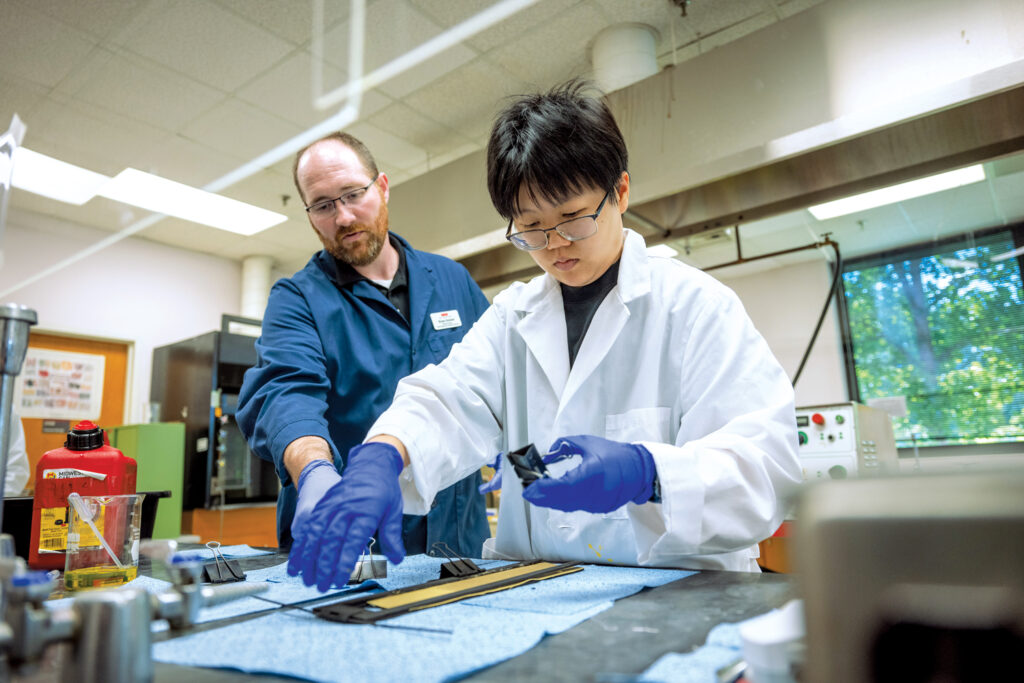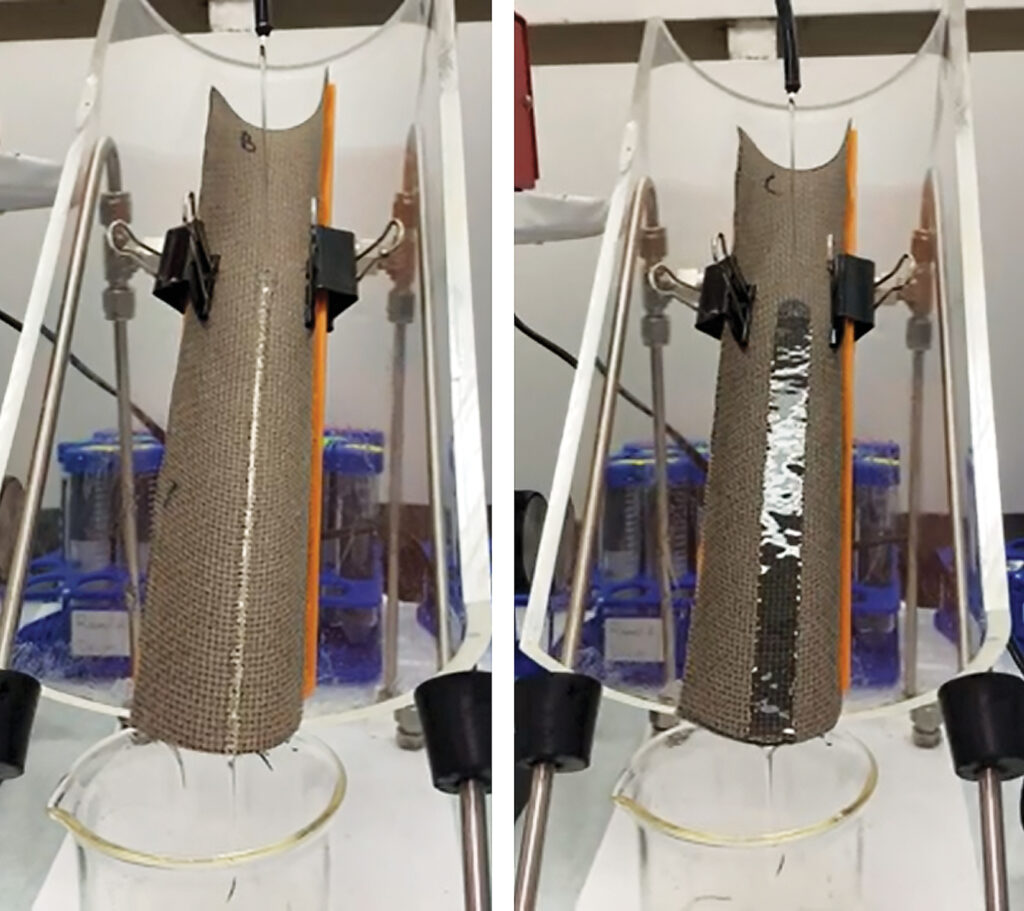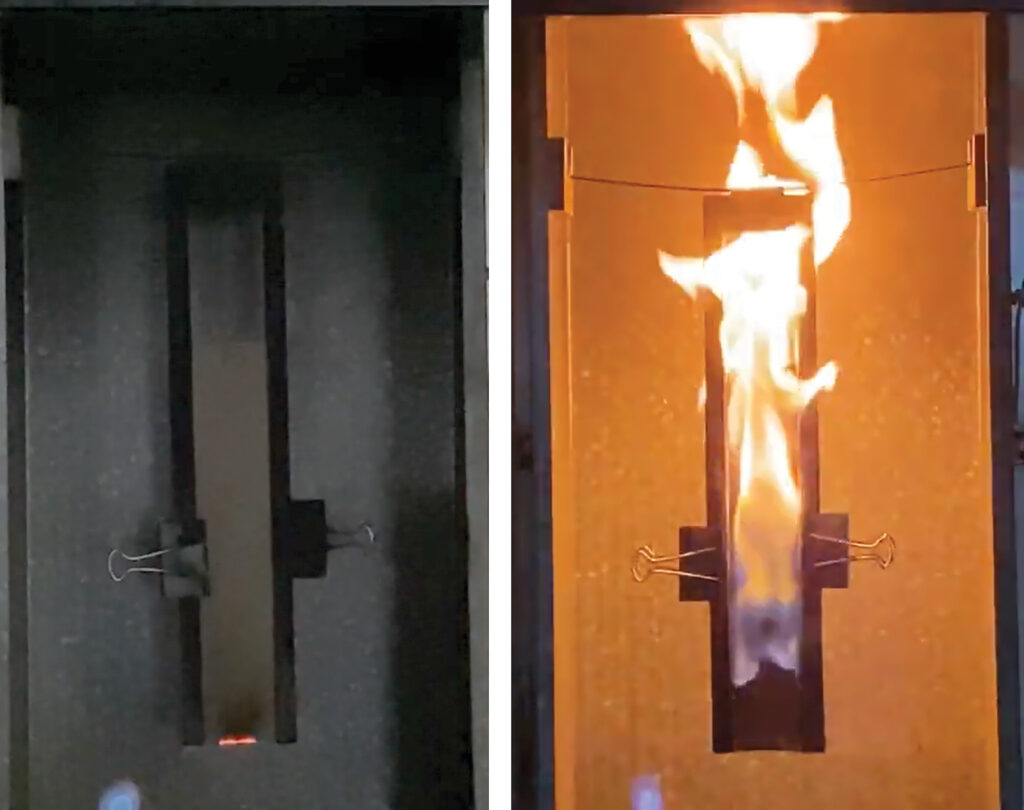
As textiles move away from per- and polyfluoroalkylsubstances (PFAS), the firefighter turnout-gear market, for one, faces specific concerns. In the past, the market intentionally used PFAS treatments to achieve goals such as oil repellency. Now, health concerns about the “forever” chemicals have led to increased regulations such as New York and California laws effective January 2025 that ban the sale and distribution of textile goods containing PFAS and other state laws that regulate firefighter gear specifically (see sidebar at the end of this article).
Key to the transition in the firefighter turnout gear market is understanding any trade-offs in performance that come from PFAS-free gear and the impact of PFAS-free exposure on firefighters, says R. Bryan Ormond, Ph.D., assistant professor at the Textile Protection and Comfort Center in the Wilson College of Textiles at North Carolina State University in Raleigh. “The PFAS chemistries have been manufactured into gear, specifically protective clothing, for a purpose, and that intentional use makes it complicated,” he says.
Prior use of PFAS chemicals in textiles was largely to achieve water repellency, stain resistance and oil repellency. Newer, non-PFAS finishes for the consumer market address the first two issues fairly easily, Ormond says, but “when you move into that safety and health aspect, that’s where the calculation and the questioning gets a little more complicated. Every oil repellent also repels water but not the other way around.”
Ormond leads a study funded by the Federal Emergency Management Agency’s Assistance to Firefighters Grants Program to investigate the effectiveness of non-PFAS finishes on firefighter gear. His team exposed turnout gear to substances such as diesel fuel, hydraulic fluid and cooking oil to test oil repellency and flammability. “If the new finishes are not repelling [oil] and allowing chemical to soak in, then if there’s an open flame nearby, it’s possible that could ignite,” Ormond says. He noted that PFAS-free finishes are also likely to use substances such as hydrocarbon wax or silicone, which have chemical similarities to flammable liquids firefighters might encounter, such as hydrocarbon fuels including gasoline.
Test results can also vary, Ormond says, depending on which components of the turnout gear are treated with a fluorine-free finish. His team will soon study the moisture barrier component of turnout gear, focusing on the impact a shift away from PFAS may have on breathability, rather than repellency.

Turnout gear’s layers
Firefighter turnout gear consists of three layers: an outer shell, a moisture barrier and a thermal liner.
Polytetrafluoroethylene (PTFE) technology has been used in moisture barriers to create a porous network in which water molecules may pass through but larger water droplets cannot, Ormond says. Breathability is important to reduce heat stress for firefighters. Moisture barriers using non-PFAS materials such as polyurethane have different physical and chemical structures.
Chad Sears, vice president of sales at Stedfast, based in Piney Flats, Tenn., notes that each piece of firefighter gear must gain approval from the National Fire Protection Agency (NFPA), whose tests consider factors such as breathability, flame resistance and thermal protection.
Stedfast manufactures Stedair® CLEAR™, a polyurethane-based, fluorine-free moisture barrier that came to market in February 2024. Stedfast does not make gear; it sells the moisture barrier material to cut-and-sew operations in 60-inch wide, 125-foot rolls. Nevertheless, requests for the product came directly from firefighters concerned for their health. “It’s kind of like buying a car and you’re talking to the tire guy and the serpentine belt guy and a brake guy,” Sears says. “I was told best by a fire chief years ago, ‘I’m in charge of thousands of firefighters. I want to make sure what I’m buying from you, I’m hearing from you, not somebody else.’”
Development of Stedair CLEAR required multiple approvals from the NFPA, Sears says: first as an individual component, then as a composite—meaning the moisture barrier is tested in conjunction with the outer shell and thermal liner—and finally as a sewn ensemble.
The most challenging aspect of Stedair CLEAR’s development, Sears says, was finding a PFAS-free seam tape compatible with the polyurethane barrier. It took several months for Stedfast to finalize development of the chemistry and technology the company provides to a seam tape manufacturer. The tape is used to seal the tiny holes created by stitching the product, which is critical for protection from blood-borne and viral contamination.
Water repellency remains important
Most calls firefighters respond to are emergency medical calls, Ormond says. They wear the same turnout gear as when fighting a fire. Biological fluids are largely water-based, which contributes to the need to maintain water repellency in firefighter gear.
Water repellency also contributes to other safety considerations. “It’s not just about keeping the firefighter dry,” Ormond says. “If their gear is saturated, there’s two things that can happen. One: It’s heavier. They already have enough physiological stress, so we try to limit that. The other piece is that water conducts heat really effectively.” Heat transfer through water-saturated gear could potentially cause burns.
Aging also impacts the qualities of firefighter gear. “The gear’s only new the first time you wear it,” Ormond says. Subsequently, it’s affected by cumulative heat and light exposure as well as mechanical abrasions from both wear and laundering. “Heat and UV light are energetic exposures that can break down chemical bonds of the fabrics and the finishes,” Ormond says.
Some of NFPA’s testing mimics the aging process. Sears says the development of Stedair CLEAR required that the complete garment hold up to five wash/dry cycles in intense conditions. “They heat it up, they put hydraulic fluid on it, they put chlorine on it, they flex it. It’s not just washing five times in a regular washing machine,” he says.
Ormond’s team has used firefighter gear held in the collections of the Textile Protection and Comfort Center to measure PFAS levels in turnout jackets dating from the early 2000s through the 2017–2020 time frame. “We need to know where we were and what the performance was and what people were used to,” he says.


Low dermal absorption rates
Good news, Ormond says, was that levels of specific PFAS were significantly lower in the garments dating from approximately 2010 onward, and overall, the PFAS amounts decreased significantly after laundering. “So we have been moving in the right direction. Now, with a switch to non-PFAS based finishes, you’re going to see even lower amounts,” he says.
He’s also moving into research on the dermal absorption rate of PFAS. The testing methodology involves applying chemicals within a sweat solution to a thin layer of pigskin, then heating it to mimic a firefighter’s skin. The tests have been conducted with eight-, six- and four-carbon chain PFAS. “We’ve actually gotten really small levels of absorption of these three compounds, from a .2% to a .05% in an eight-hour period,” he says.
Ormond views such results as positive, indicating that it may be unlikely that the tested PFAS chemicals will absorb into skin rapidly. For context, he notes, the same testing scenario with naphthalene and phenanthrene, chemicals commonly released from burning items, produced dermal absorption rates of 35% and 7%, respectively. He also has new funding through the National Institute of Standards and Technology to assess dermal absorption of the PFAS compounds that are more specific to those found on or releasing from fabrics.
Dermal absorption is not firefighters’ only exposure to PFAS chemicals. They may also inhale or ingest them as lint from their gear, Ormond says. Neither are PFAS the only carcinogens firefighters are exposed to, with others present in the smoke and other chemicals they’re exposed to on the job. “Removing PFAS from the gear is not a cure for cancer in the fire service, but it is an important step in the right direction,” Ormond says.
Moving to PFAS-free firefighter turnout gear is a complicated process with many unknowns, Ormond says. “What we’re trying to understand in this trade space is: What exposures are you actually getting from these fabrics, from wearing them specifically? What performance are you giving up that you were getting previously? And how do you balance that?”
Changes in oil repellency, for example, would require shifts in firefighter training and practices, he says. For example, if a firefighter attired in gear with a lower level of oil repellency were exposed to flammable fuels such as diesel or gasoline, “That person may need to be pulled out until they have another set of gear on. And that’s really hard,” he says.
Still, Ormond feels that manufacturers can and should find PFAS substitutes that still deliver the performance previously found in
the long-lasting chemicals.
Sears says his company already makes fluorine-free booties—the moisture barrier for firefighter boots—and is looking to expand the technology used in Stedair CLEAR to other sectors. Product development, he says, will be market-driven. “It’s our job to listen to our customer base, which is firefighters,” Sears says. “We’re there for their well-being and for firefighter safety.”
Joanna Werch Takes is a writer and editor based in Minnesota.
SIDEBAR: PFAS reporting roll-out potentially delayed
The start date for businesses to begin reporting PFAS data, previously Nov. 12, 2024, has been pushed back until July 11, 2025, also extending the end date. This proposal went up for public comment in early September for about a month, ending Oct. 7.
“Maintaining that [current] deadline would require entities to submit data before EPA has the technological capacity in place to accept that data,” the proposal on the federal register says. The EPA also needs time to beta-test the PFAS reporting software and revise it based on that testing.
Data being collected includes information on PFAS uses, production volumes, disposal, exposures and hazards dating back to 2011.
The rule affects manufacturers, including importers of PFAS or PFAS-containing items.
The EPA attributes the delay to budgetary issues.
SIDEBAR: PFAS laws on firefighter gear
Although many of the PFAS-related laws pertaining to firefighting concern the chemical being in the foam, some states also have adopted regulations about turnout gear specifically:
- Colorado, Maryland, New Hampshire, New York: Requiring notification of PFAS in turnout gear
- Indiana: Prohibiting fire departments from purchasing gear that isn’t labeled as to whether it includes PFAS
- Maine: Appropriating one-time grants to purchase PFAS-free gear
- Massachusetts: Requiring notification of PFAS in turnout gear Jan. 1, 2025, and prohibiting PFAS gear Jan. 1, 2027
- New Hampshire and Connecticut: Prohibiting PFAS-containing gear as of Jan. 1, 2025
Source: SaferStates.org
To follow the latest laws being introduced or those that have been approved relating to the chemical compound in textiles, visit ATA’s PFAS Resource Center at textiles.org/education/pfas-resource-center.
 TEXTILES.ORG
TEXTILES.ORG


